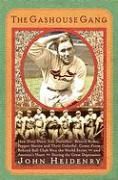


Baseball Toaster was unplugged on February 4, 2009.
Email me at btimmermann@gmail.com
Select a date:
 When you pick up a book about the 1934 St. Louis Cardinals, you should expect a lot of stories about Dizzy Dean. And John Heidenry has a lot of those in his book, The Gashouse Gang. The book has the lengthy subtitle of How Dizzy Dean, Leo Durocher, Branch Rickey, Pepper Martin, and Their Colorful, Come-From-Behind Ball Club Won the World Series – and America’s Heart – During the Great Depression. But the subtitle may end up telling you more about the other players on the 1934 Cardinals not named Dizzy Dean than you will find in the book.
When you pick up a book about the 1934 St. Louis Cardinals, you should expect a lot of stories about Dizzy Dean. And John Heidenry has a lot of those in his book, The Gashouse Gang. The book has the lengthy subtitle of How Dizzy Dean, Leo Durocher, Branch Rickey, Pepper Martin, and Their Colorful, Come-From-Behind Ball Club Won the World Series – and America’s Heart – During the Great Depression. But the subtitle may end up telling you more about the other players on the 1934 Cardinals not named Dizzy Dean than you will find in the book.
Without a doubt, Dizzy Dean was the story in baseball in 1934. He won 30 games and helped spur the Cardinals to make up a 5-game deficit to the New York Giants on Labor Day and a 2-½ game deficit with a week left in the season. And then the Cardinals went on to beat the Detroit Tigers in a hard-fought seven game World Series.
While this was going on, Dean, along with his brother Paul, went on a brief strike in the middle of August in a dispute over fines for skipping an exhibition game in Detroit, and yet the Cardinals still were able to still pull off their comeback. With Babe Ruth’s career on the wane, Dean filled the PR vacuum that the American baseball media needed to fill.
But the 1934 Cardinals were more than just Dean. They were put together by one of baseball’s greatest executives in Branch Rickey. They were led by player-manager Frankie Frisch, a future Hall of Famer. The team’s best hitter was another Hall of Famer in Joe Medwick, who was moody and unpopular with his teammates. Pepper Martin, “The Wild Horse of the Osage”, was a disruptive force on the base paths and a colorful presence off the field. Leo Durocher played shortstop, and despite his mediocre hitting, was solid on defense. He also told the team’s second baseman during the 1934 Series that he wasn’t going to help him out by playing up the middle more. However, the second baseman was Frisch.
The problem I had with Heidenry’s book is that after he introduces the supporting cast to Dizzy Dean in the opening chapter, the rest of the Gashouse Gang just sort of fades into the background. And the story of the 1934 season turns into a story about Dizzy Dean.
And while reading about Dean is not a bad thing, but you can find the same thing in Robert Gregory’s Diz: The Story of Dizzy Dean and Baseball During the Great Depression, which came out in 1992. I wanted to find out more about Martin and Medwick. But Martin continues to exist in the history books as a cartoon character and Medwick’s tempestuous relationship with his teammates (which seemed to stem from self-esteem issues) is only hinted at.
The Gashouse Gang, a name that was not applied to the 1934 Cardinals until 1935, was more than just Dizzy Dean. They were a one-year collection of some great players having career seasons who pulled off one of the more improbable late-season pennant runs. They never made a serious pennant run again after the magical 1934 season.
This is Heidenry’s second book on the Cardinals in two years. Last year, along with Brett Topel, he wrote about the 1944 World Series between the Cardinals and Browns in The Boys Who Were Left Behind. I’m not sure what’s next for Heidenry. Does he go back to write about the 1924 Cardinals, a team managed by Branch Rickey and featuring Rogers Hornsby batting .424 and still lost 89 games? Probably not.
The Cardinals franchise has a rich history and the 1934 squad may have the most stories to tell. But I just didn’t hear enough of them in this book.
1.
2.
3.
4.
5.
6.
7.
8.
9.
10. Three Nights in August
There have also been two books on Curt Flood published in the last two years, including one by Alex Belth last year.
Halberstam's "October, 1964" is pretty mediocre imo.
I have a later edition of Lieb's book about the Cardinals. It goes through World War II I believe.
I forgot to mention that before there was George Steinbrenner firing managers, there was Sam Breadon, who never thought that there was a situation that couldn't be solved by firing the manager. And he fired FOUR Hall of Famers as managers I believe: Rickey, Hornsby, McKechnie, and Frisch.
Originally published by Atheneum and NAL/Signet in 1982-83, all comments invited, especially about Rickey's years with the Cardinals and Pirates (but also including the Brooklyn Dodgers).
Murray Polner
Comment status: comments have been closed. Baseball Toaster is now out of business.